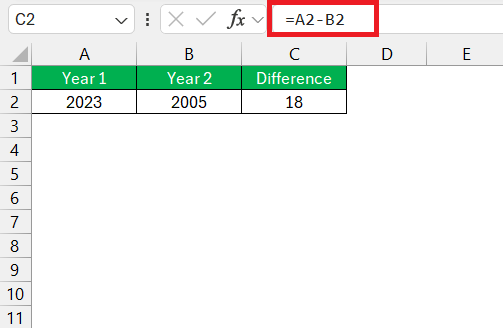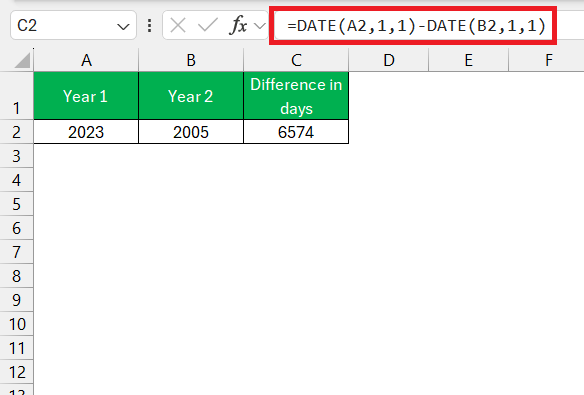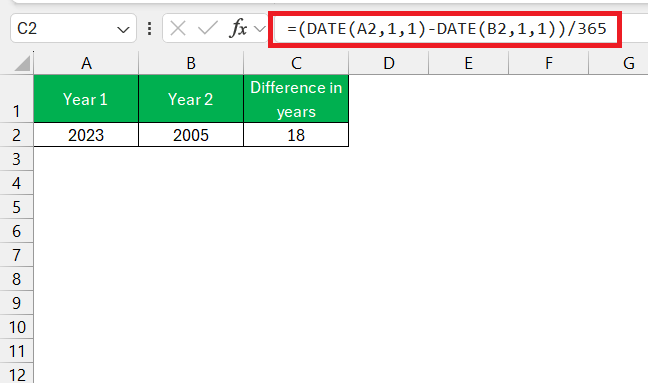Microsoft Excel’s powerful toolbox allows users to handle dates and times effortlessly, enabling the manipulation and computation of time-related data for various applications. Whether for planning or retrospection, understanding date calculations in Excel can significantly enhance productivity. This guide explores the importance and practical uses of calculating 2023 minus 2005 years in Excel, from calculating amortization schedules in finance to determining employee tenure in HR.
Key Takeaways:
- The DATE Function: Essential for year subtraction, the DATE function combines year, month, and day elements to create specific dates. Adjusting the year element helps find past or future dates easily.
- Direct Year Difference Calculation: Simple formulas like =2023-2005 quickly calculate the number of years between two points. For precise date calculations, combine the DATE function with arithmetic.
- Excel’s Date System: Excel treats dates as serial numbers starting from January 1, 1900, enabling complex date calculations through various arithmetic operations.
- Key Functions for Date Arithmetic: Functions like YEAR, MONTH, DAY, EDATE, DATEADD, DATEDIF, and NETWORKDAYS allow for extracting date components, calculating differences, and adding increments.
- Practical Applications: Subtracting years in Excel is useful in project management for estimating timespans, in finance for computing depreciation, and in HR for determining tenure, showcasing Excel’s versatility in date calculations.
Table of Contents
Introduction
The Magic of Excel in Date Calculations
Excel’s powerful toolbox has long given you the capability to handle dates and times effortlessly. Harnessing this potential allows them to manipulate and compute time-related data — whether they’re planning or looking back.
Why Subtract Years in Excel?
Subtracting years in Excel might seem like a niche skill, but it has a myriad of practical uses. Those working in finance might use it to calculate amortization schedules or bond maturities, while human resources professionals often need it for determining employee tenure or retirement dates.
In personal projects, one might subtract years to track anniversaries or to know how long ago an event took place simply. Whatever the reason, being able to do this efficiently in Excel is a valuable time-saver.
Quick Start Guide to Subtraction of Years
The DATE Function: Your Friend for Year Subtraction
The DATE function in Excel is a powerful ally when it comes to subtracting years. This function is designed to combine individual year, month, and day elements into a complete date. For year subtraction, you focus on altering the year element while keeping months and days constant or adjusting them as needed.
Imagine they want to see what the date was exactly five years ago from a given date. They’d use the DATE function, subtracting the number of years from the year part of their starting date, and let the function do the rest. It’s straightforward yet effective.
Direct Formula for Calculating 2023 Minus 2005
To figure out the year difference, such as calculating 2023 minus 2005, Excel makes it quick and simple. You can use a direct formula: =2023-2005. This straightforward calculation will return the number of years between the two, which is 18.
However, for actual date calculations including the day and month, you’d adjust to a formula like this: =DATE(2023,1,1)-DATE(2005,1,1). This version gives you the number of days between two dates.
You could divide by 365 to convert that number to years.
It’s essential to remember that if they’re working with specific dates that span leap years, the division would be by 365.25 to account for the extra day every four years.
Understanding Excel’s Date System
The Basics of Excel Date and Time
Excel treats dates and times as serial numbers, with January 1, 1900, as the starting point (serial number 1). This means that each subsequent day is represented as a number incremented by one. For instance, January 2, 1900, is serial number 2, and so on. Time is represented as fractional values of a day; for example, 6 AM is 0.25, reflecting a quarter of the day gone.
Given this system, Excel can perform a variety of arithmetic operations on dates and times. When they format these serial numbers as a date or time, Excel displays them according to that formatting, but the underlying value is still a serial number.
This fundamental understanding is crucial for effective date calculations and manipulations in Excel.
Key Functions for Date Arithmetic
Beyond the DATE function, Excel offers several other key functions to perform date arithmetic. Here’s a quick rundown:
- YEAR, MONTH, DAY: These extract the year, month, and day parts from a date, which can then be used in calculations.
- EDATE: Handy for adding a specific number of months to a date, EDATE is great for monthly increments or decrements.
- DATEADD: Like EDATE, but it can add years, months, or days to a date.
- DATEDIF: Calculated the difference between two dates. This is ideal for figuring out the exact number of years, months, or days between two points in time.
- NETWORKDAYS: If they need to calculate the number of working days between two dates, excluding weekends and possibly holidays, NETWORKDays is the function to go for.
Each function has its unique purpose and can be combined to solve complex date-related problems.
Practical Examples and Scenarios
Project Management: Estimating Timespans Between Dates
In project management, accurately estimating the timespan between dates is crucial for planning and tracking progress. For instance, when they wish to add two weeks to a project’s start date to estimate a new completion date, they could use a formula like =EDATE(start_date, 2) if they’re measuring in months, or =start_date + 14 for a precise two-week addition.
For calculating the duration of a project phase, the formula =end_date - start_date gives them the number of days. If they want to exclude weekends or holidays from the count, they can turn to the NETWORKDAYS function which takes the start date, end date, and a list of holidays to give back the number of workdays.
These functions help project managers to build robust timelines and to adjust schedules as dates shift over the life of a project.
Financial Analysis: Computing Depreciation Over Years
In the realm of financial analysis, determining the depreciation of an asset over time is a common task. To compute depreciation, they need to know the asset’s useful life and apply a formula that takes into account the number of years the asset will be in use. For example, with the straight-line method, they would divide the asset’s cost minus its salvage value by its useful life in years.
Using Excel, they set up formulas like =(Cost - Salvage_Value) / Useful_Life to calculate annual depreciation. If they prefer to work with dates, they could use the DATEDIF function to determine the asset’s age and calculate depreciation accordingly.
As they project into the future, these computations help inform on the financial health of their organization, making year subtraction an invaluable analysis tool.
Troubleshooting Common Errors
Dealing with #VALUE! and Other Error Messages
When working with dates and subtraction formulas, encountering error messages like #VALUE! is common. This often indicates that Excel is interpreting their input as text instead of a date.
To fix these mistakes, they need to ensure the cells they are working with are formatted correctly as dates. If that doesn’t solve the issue, they might need to use the DATEVALUE function to convert text representations of dates into Excel’s date format.
Also, be wary of leap years or inconsistencies in date formats within their data. These can throw off calculations and give unexpected errors. A bit of data cleaning or utilizing text functions like LEFT, RIGHT, and MID might be necessary to standardize the date formats across their dataset.
Ensuring Accuracy in Your Year Difference Calculations
Accuracy in year-difference calculations in Excel hinges on proper date formatting and a clear understanding of the functions and formulas used. To ensure accuracy, they should:
- Double-check that all dates are entered correctly and consistently across their worksheet.
- Ensure the cell formats match their needs—date formats for dates, and general or number formats for results.
- Review the formulas they use, especially functions like
DATEDIFandNETWORKDAYS, to verify they suit their calculation requirements. - Factor in leap years when calculating spans over several years to avoid slight deviations over long periods.
- Test their functions with known values to confirm they’re getting expected results.
Taking these steps helps maintain integrity in their calculations and trust in their Excel analyses.
FAQs
How to subtract a year in Excel?
To subtract a year in Excel, use the DATE function with the following formula in a cell: =DATE(YEAR(A1)-1, MONTH(A1), DAY(A1)) where A1 is the cell containing the date from which a year will be subtracted. This will return the same date but a year earlier, accounting for leap years automatically.
How do I calculate the number of years between two dates in Excel?
To calculate the number of years between two dates in Excel, use the YEARFRAC function like so: =YEARFRAC(start_date, end_date). This function will give you the year difference as a decimal. For whole years, use the DATEDIF function: =DATEDIF(start_date, end_date, "Y").
Can Excel automatically update the subtraction result as years pass?
Yes, Excel can automatically update the subtraction result as years pass by using the TODAY function in your calculations. For example, =DATEDIF(start_date, TODAY(), "Y") will calculate the number of years from the start date to the current date and update as time progresses.
How do I calculate an age in Excel?
To calculate age in Excel, you can use the DATEDIF function with the “Y” unit: =DATEDIF(birth_date, TODAY(), "Y"). This returns the age in complete years as of the current date, automatically updating each day.
How do I subtract dates in Excel 2007?
In Excel 2007, to subtract dates, simply input the later date in a cell (say, A1), the earlier date in another cell (B1), and use the formula =A1-B1 in a third cell to find the difference in days. To convert this to years, divide by 365: (A1-B1)/365.
John Michaloudis is a former accountant and finance analyst at General Electric, a Microsoft MVP since 2020, an Amazon #1 bestselling author of 4 Microsoft Excel books and teacher of Microsoft Excel & Office over at his flagship MyExcelOnline Academy Online Course.










